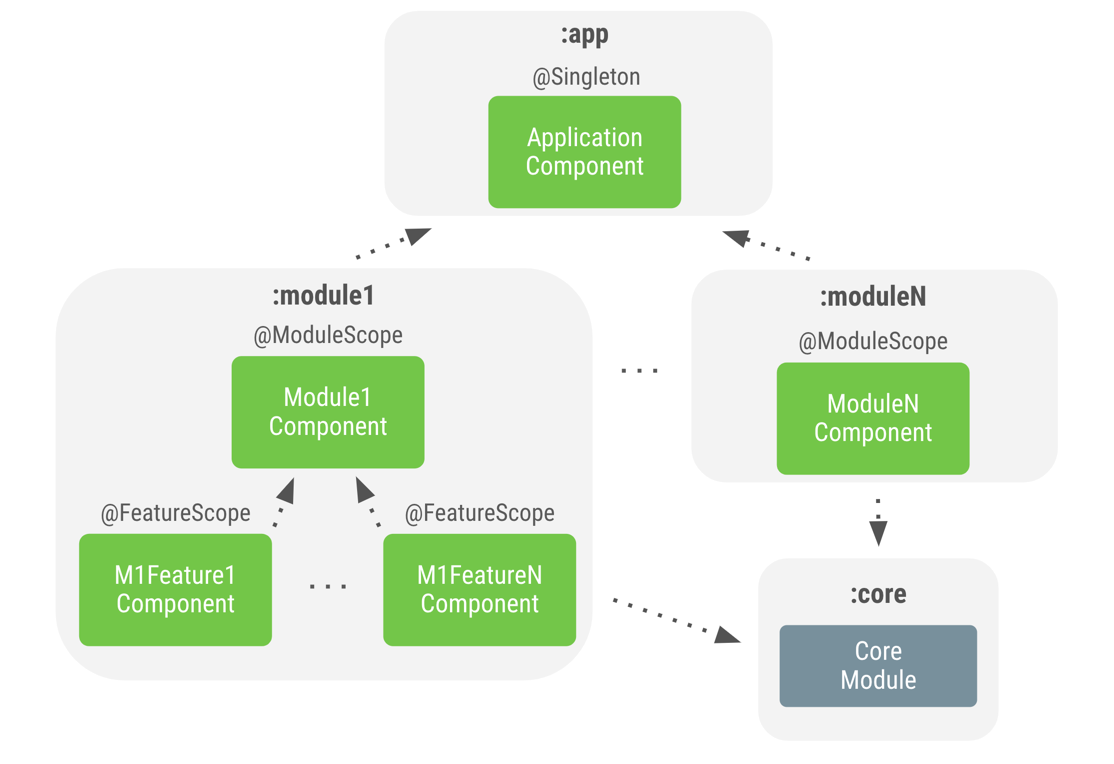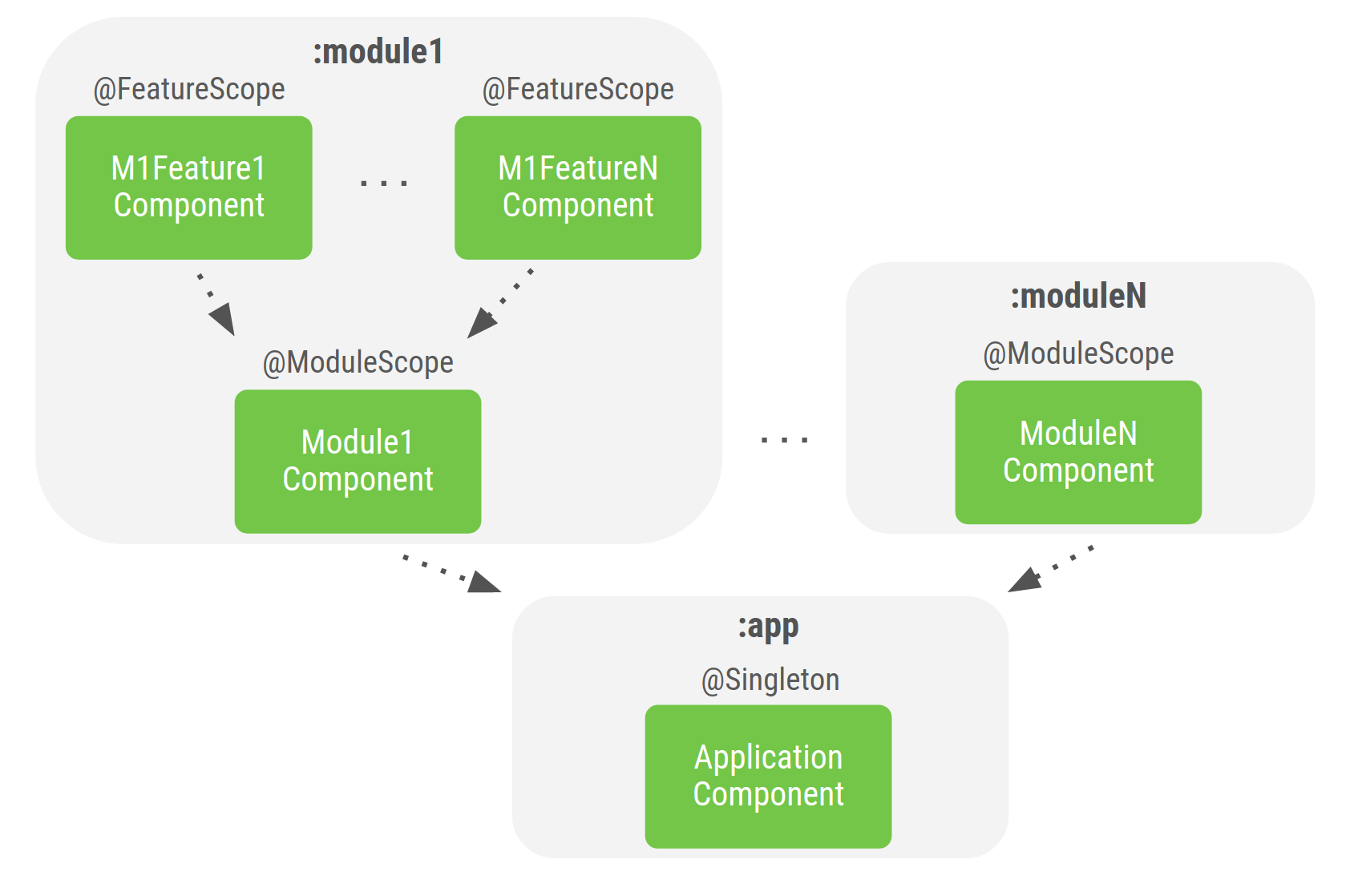具有多个 Gradle 模块的项目称为多模块项目。在一个作为单个 APK 发布且没有功能模块的多模块项目中,通常会有一个app模块,它可以依赖于项目的大多数模块,以及一个base或core模块,其余模块通常依赖于它。app模块通常包含您的Application类,而base模块包含项目中所有模块共享的所有公共类。
app模块是声明应用程序组件(例如,下图中的ApplicationComponent)的好地方,该组件可以提供其他组件可能需要的对象以及应用程序的单例。例如,OkHttpClient、JSON 解析器、数据库访问器或可能在core模块中定义的SharedPreferences对象等类将由在app模块中定义的ApplicationComponent提供。
在app模块中,您还可以拥有其他生命周期较短的组件。一个示例可能是UserComponent,它在登录后具有特定于用户的配置(例如UserSession)。
在项目的不同模块中,您可以定义至少一个子组件,该子组件具有特定于该模块的逻辑,如图 1 所示。

图 1. 多模块项目中 Dagger 图表的示例
例如,在login模块中,您可以使用自定义@ModuleScope注释定义一个使用LoginComponent作用域的组件,该组件可以提供该功能通用的对象,例如LoginRepository。在该模块中,您还可以拥有其他依赖于LoginComponent且具有不同自定义作用域的组件,例如@FeatureScope用于LoginActivityComponent或TermsAndConditionsComponent,您可以在其中定义更特定于功能的逻辑,例如ViewModel对象。
对于其他模块,例如Registration,您将拥有类似的设置。
多模块项目的一般规则是,同一级别的模块不应该相互依赖。如果它们确实相互依赖,请考虑该共享逻辑(它们之间的依赖关系)是否应该是父模块的一部分。如果是,则重构以将类移动到父模块;如果不是,则创建一个扩展父模块的新模块,并让两个原始模块都扩展新模块。
作为最佳实践,您通常会在以下情况下在模块中创建一个组件
您需要执行字段注入,就像使用
LoginActivityComponent一样。您需要对对象进行作用域限定,就像使用
LoginComponent一样。
如果这两种情况都不适用,并且您需要告诉 Dagger 如何从该模块提供对象,请创建并公开一个 Dagger 模块,其中包含@Provides或@Binds方法(如果这些类的构造函数注入不可行)。
使用 Dagger 子组件的实现
在 Android 应用中使用 Dagger 文档页面介绍了如何创建和使用子组件。但是,您不能使用相同的代码,因为功能模块不知道app模块。例如,如果您考虑典型的登录流程以及我们上一页中的代码,它将不再编译
Kotlin
class LoginActivity: Activity() { ... override fun onCreate(savedInstanceState: Bundle?) { // Creation of the login graph using the application graph loginComponent = (applicationContext as MyDaggerApplication) .appComponent.loginComponent().create() // Make Dagger instantiate @Inject fields in LoginActivity loginComponent.inject(this) ... } }
Java
public class LoginActivity extends Activity { ... @Override protected void onCreate(Bundle savedInstanceState) { // Creation of the login graph using the application graph loginComponent = ((MyApplication) getApplicationContext()) .appComponent.loginComponent().create(); // Make Dagger instantiate @Inject fields in LoginActivity loginComponent.inject(this); ... } }
原因是login模块不知道MyApplication也不知appComponent。要使其工作,您需要在功能模块中定义一个接口,该接口提供MyApplication需要实现的FeatureComponent。
在下面的例子中,您可以定义一个名为 LoginComponentProvider 的接口,它在 login 模块中提供 LoginComponent,用于登录流程。
Kotlin
interface LoginComponentProvider { fun provideLoginComponent(): LoginComponent }
Java
public interface LoginComponentProvider { public LoginComponent provideLoginComponent(); }
现在,LoginActivity 将使用该接口,而不是上面定义的代码片段。
Kotlin
class LoginActivity: Activity() { ... override fun onCreate(savedInstanceState: Bundle?) { loginComponent = (applicationContext as LoginComponentProvider) .provideLoginComponent() loginComponent.inject(this) ... } }
Java
public class LoginActivity extends Activity { ... @Override protected void onCreate(Bundle savedInstanceState) { loginComponent = ((LoginComponentProvider) getApplicationContext()) .provideLoginComponent(); loginComponent.inject(this); ... } }
现在,MyApplication 需要实现该接口并实现所需的方法。
Kotlin
class MyApplication: Application(), LoginComponentProvider { // Reference to the application graph that is used across the whole app val appComponent = DaggerApplicationComponent.create() override fun provideLoginComponent(): LoginComponent { return appComponent.loginComponent().create() } }
Java
public class MyApplication extends Application implements LoginComponentProvider { // Reference to the application graph that is used across the whole app ApplicationComponent appComponent = DaggerApplicationComponent.create(); @Override public LoginComponent provideLoginComponent() { return appComponent.loginComponent.create(); } }
这就是在多模块项目中使用 Dagger 子组件的方法。对于功能模块,由于模块之间的依赖方式不同,解决方案也不同。
功能模块的组件依赖
对于 功能模块,模块之间通常的依赖方式是反向的。功能模块依赖于 app 模块,而不是 app 模块包含功能模块。请参阅图 2,了解模块的结构表示。

图 2. 带有功能模块的项目中 Dagger 图的示例
在 Dagger 中,组件需要了解其子组件。此信息包含在添加到父组件的 Dagger 模块中(例如,在 Android 应用中使用 Dagger 中的 SubcomponentsModule 模块)。
不幸的是,由于应用和功能模块之间的依赖关系反转,子组件在 app 模块中不可见,因为它不在构建路径中。例如,在 login 功能模块中定义的 LoginComponent 不能是 app 模块中定义的 ApplicationComponent 的子组件。
Dagger 有一个称为 **组件依赖** 的机制,您可以使用它来解决此问题。子组件不是父组件的子组件,而是依赖于父组件。这样,就没有父子关系;现在 **组件** 依赖于其他组件来获取某些 **依赖项**。组件需要公开图中的类型,以便依赖组件使用它们。
例如:名为 login 的功能模块想要构建一个依赖于 app Gradle 模块中可用的 AppComponent 的 LoginComponent。
以下是属于 app Gradle 模块的类和 AppComponent 的定义。
Kotlin
// UserRepository's dependencies class UserLocalDataSource @Inject constructor() { ... } class UserRemoteDataSource @Inject constructor() { ... } // UserRepository is scoped to AppComponent @Singleton class UserRepository @Inject constructor( private val localDataSource: UserLocalDataSource, private val remoteDataSource: UserRemoteDataSource ) { ... } @Singleton @Component interface AppComponent { ... }
Java
// UserRepository's dependencies public class UserLocalDataSource { @Inject public UserLocalDataSource() {} } public class UserRemoteDataSource { @Inject public UserRemoteDataSource() { } } // UserRepository is scoped to AppComponent @Singleton public class UserRepository { private final UserLocalDataSource userLocalDataSource; private final UserRemoteDataSource userRemoteDataSource; @Inject public UserRepository(UserLocalDataSource userLocalDataSource, UserRemoteDataSource userRemoteDataSource) { this.userLocalDataSource = userLocalDataSource; this.userRemoteDataSource = userRemoteDataSource; } } @Singleton @Component public interface ApplicationComponent { ... }
在包含 app Gradle 模块的 login Gradle 模块中,您有一个 LoginActivity,它需要注入 LoginViewModel 实例。
Kotlin
// LoginViewModel depends on UserRepository that is scoped to AppComponent class LoginViewModel @Inject constructor( private val userRepository: UserRepository ) { ... }
Java
// LoginViewModel depends on UserRepository that is scoped to AppComponent public class LoginViewModel { private final UserRepository userRepository; @Inject public LoginViewModel(UserRepository userRepository) { this.userRepository = userRepository; } }
LoginViewModel 依赖于 UserRepository,它在 AppComponent 中可用并具有作用域。让我们创建一个依赖于 AppComponent 以注入 LoginActivity 的 LoginComponent。
Kotlin
// Use the dependencies attribute in the Component annotation to specify the // dependencies of this Component @Component(dependencies = [AppComponent::class]) interface LoginComponent { fun inject(activity: LoginActivity) }
Java
// Use the dependencies attribute in the Component annotation to specify the // dependencies of this Component @Component(dependencies = AppComponent.class) public interface LoginComponent { void inject(LoginActivity loginActivity); }
LoginComponent 通过将其添加到组件注释的依赖参数中来指定对 AppComponent 的依赖关系。因为 LoginActivity 将由 Dagger 注入,所以请将 inject() 方法添加到接口中。
创建 LoginComponent 时,需要传入 AppComponent 的实例。使用组件工厂来实现。
Kotlin
@Component(dependencies = [AppComponent::class]) interface LoginComponent { @Component.Factory interface Factory { // Takes an instance of AppComponent when creating // an instance of LoginComponent fun create(appComponent: AppComponent): LoginComponent } fun inject(activity: LoginActivity) }
Java
@Component(dependencies = AppComponent.class) public interface LoginComponent { @Component.Factory interface Factory { // Takes an instance of AppComponent when creating // an instance of LoginComponent LoginComponent create(AppComponent appComponent); } void inject(LoginActivity loginActivity); }
现在,LoginActivity 可以创建 LoginComponent 的实例并调用 inject() 方法。
Kotlin
class LoginActivity: Activity() { // You want Dagger to provide an instance of LoginViewModel from the Login graph @Inject lateinit var loginViewModel: LoginViewModel override fun onCreate(savedInstanceState: Bundle?) { // Gets appComponent from MyApplication available in the base Gradle module val appComponent = (applicationContext as MyApplication).appComponent // Creates a new instance of LoginComponent // Injects the component to populate the @Inject fields DaggerLoginComponent.factory().create(appComponent).inject(this) super.onCreate(savedInstanceState) // Now you can access loginViewModel } }
Java
public class LoginActivity extends Activity { // You want Dagger to provide an instance of LoginViewModel from the Login graph @Inject LoginViewModel loginViewModel; @Override protected void onCreate(Bundle savedInstanceState) { super.onCreate(savedInstanceState); // Gets appComponent from MyApplication available in the base Gradle module AppComponent appComponent = ((MyApplication) getApplicationContext()).appComponent; // Creates a new instance of LoginComponent // Injects the component to populate the @Inject fields DaggerLoginComponent.factory().create(appComponent).inject(this); // Now you can access loginViewModel } }
LoginViewModel 依赖于 UserRepository;为了使 LoginComponent 能够从 AppComponent 访问它,AppComponent 需要在它的接口中公开它。
Kotlin
@Singleton @Component interface AppComponent { fun userRepository(): UserRepository }
Java
@Singleton @Component public interface AppComponent { UserRepository userRepository(); }
依赖组件的作用域规则与子组件的作用域规则相同。因为 LoginComponent 使用 AppComponent 的实例,所以它们不能使用相同的作用域注释。
如果您想将 LoginViewModel 的作用域设置为 LoginComponent,您可以像以前一样使用自定义 @ActivityScope 注释来实现。
Kotlin
@ActivityScope @Component(dependencies = [AppComponent::class]) interface LoginComponent { ... } @ActivityScope class LoginViewModel @Inject constructor( private val userRepository: UserRepository ) { ... }
Java
@ActivityScope @Component(dependencies = AppComponent.class) public interface LoginComponent { ... } @ActivityScope public class LoginViewModel { private final UserRepository userRepository; @Inject public LoginViewModel(UserRepository userRepository) { this.userRepository = userRepository; } }
最佳实践
ApplicationComponent应该始终位于app模块中。如果您需要在该模块中执行字段注入,或者需要为应用程序的特定流程作用域对象,请在模块中创建 Dagger 组件。
对于旨在用作实用程序或帮助程序且不需要构建图的 Gradle 模块(这就是您需要 Dagger 组件的原因),请创建并公开具有 @Provides 和 @Binds 方法的公共 Dagger 模块,这些方法不支持构造函数注入的类。
要在具有功能模块的 Android 应用中使用 Dagger,请使用组件依赖项以访问
app模块中定义的ApplicationComponent提供的依赖项。
